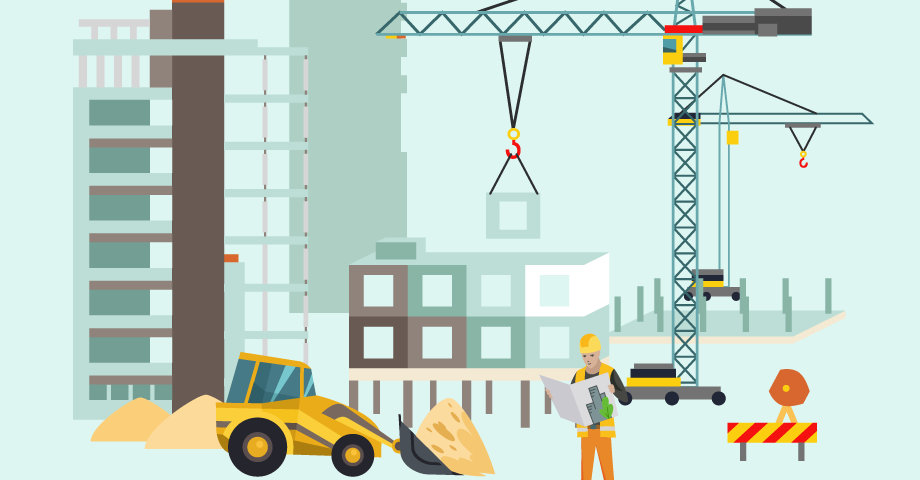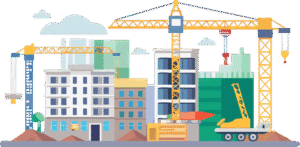Maybe it didn’t feel like it in 2024, but last year the construction industry benefitted from strong fundamentals. Sure, there were challenges—like the high cost of construction, supply chain disruptions, labor shortages, and high borrowing costs, to name a few—but despite those, the construction industry grew 10% in nominal value, 12% in gross output and construction spending topped $2 trillion in the first half of last year. All of these are reasons to be confident about the state of construction and development. Now, as borrowing costs are coming down and market volatility wanes, the construction industry is gaining momentum for more growth moving into 2025.
Several construction outlook reports have an optimistic forecast for commercial real estate construction in the coming year. Here is what developers can expect in four key construction areas for 2025:
New Construction Starts
High interest rates were a key factor of the diminished new construction activity in 2023 and 2024. As rates begin to fall next year and loan originations increase, new construction starts should begin to pick back up. JLL’s 2025 Construction Outlook estimates new construction activity will begin to pick up in late 2025. Multifamily starts, which fell to record lows this year, will rebound in 2025 as the market absorbs new supply deliveries this year. The Dodge Construction Forecast expects overall residential starts will increase a total of 11.5% next year, while Construct Connect expects multifamily starts to increase by 9.5% next year. Non-residential starts are expected to increase 5.9% next year, driven by new construction of hotels, retail and healthcare facilities.
Construction Spending
Alongside increases in new construction starts, construction spending is will be on the upswing throughout 2025. JLL predicts a net gain in new construction spending next year for both private residential and private nonresidential development. According to the Dodge Construction Forecast, dollar volume of construction starts will increase 8.6% in 2025. FMI, on the other hand, estimates a 2% gain in multifamily spending next year, lower than growth in 2024. For multifamily, the firm forecasts lagging growth over the next five years with more than a 15% drop in put-in-place multifamily spending next year. The American Institute of Architects shares this outlook, predicting a 2% increase in construction spending next year in what it called a “stall” in activity in its mid-year report.
Construction Costs
Construction costs are a critical indicator of the health of the construction market. Construction costs have increased significantly since the pandemic, and the National Association of Home Builders estimates that construction costs now make up 23.8% of the total cost of construction. JLL estimates that construction costs will increase across materials types, increasing between 5% and 7% inn 2025. On the upside, labor costs are expected to decelerate, growing .9% next year compared to 1.7% in 2024. There is concern about how tariffs implemented by the incoming administration might raise costs even further. Commercial Real Estate Developers can offset some of these costs by investing in modern real estate development software that can create valuable efficiencies in project management through the automation of administrative tasks, tracking spending and producing financial forecasts. As a result, developers are not only able to reach targeted investment outcomes but also reduce budgets by 6% and reduce overages by 66%. This savings can go a long way to offsetting construction cost increases.
Construction Financing
Developers are finally taking a win after two years of interest rate increases, volatility, and a tightening capital market environment. Interest rates have already started to decline with some, albeit nominal, easing in the 10-year treasury. Moving into 2025, experts predict more interest rate cuts will come. JP Morgan forecasts four interest rate cuts next year, with the Federal Funds rates ending 2025 at 3.5%. JLL predicts that lower rates will help support a better environment for construction financing, with more construction loan origination activity next year for residential and nonresidential development. JLL’s report noted that residential construction in particular will benefit from lower interest rates, as lower rates support both supply and demand side spending. However, Richard Branch, chief economist at Dodge Construction Network, said that it will take a 125 to 150 basis point reduction in rates before we begin to see consistent growth in the construction market. “We know that construction activity, for the most part, has been moving fairly sideways over the last [six months],” he told Engineering News Record. “Rate cuts at that level are “’what’s really going to get the gears kind of turning here.’”
Climate Challenges
While the construction industry is improving, climate challenges have the potential to derail growth. States with the highest disaster risk, like California, Florida and Texas, account for more than half of construction GDP growth. JLL notes, “Heat, storms, and flooding require conscious intervention to our building practices and patterns if development is going to proceed at the concentrations forecast without unduly compounding potential losses.” The report recommends developers build for resiliency and prepare for the impact of infrastructure investments following natural disasters. This includes shifting organizational patterns, adopting new technologies, and adapting to rapidly changing policy and regulations.
Although there remain some challenges, the construction industry’s outlook is bright. Developers should look forward to improving construction activity and capital markets and lower construction costs as 2025 gets started.



